Discover the Compelling Secrets of Tombs of the Nobles in Saqqara
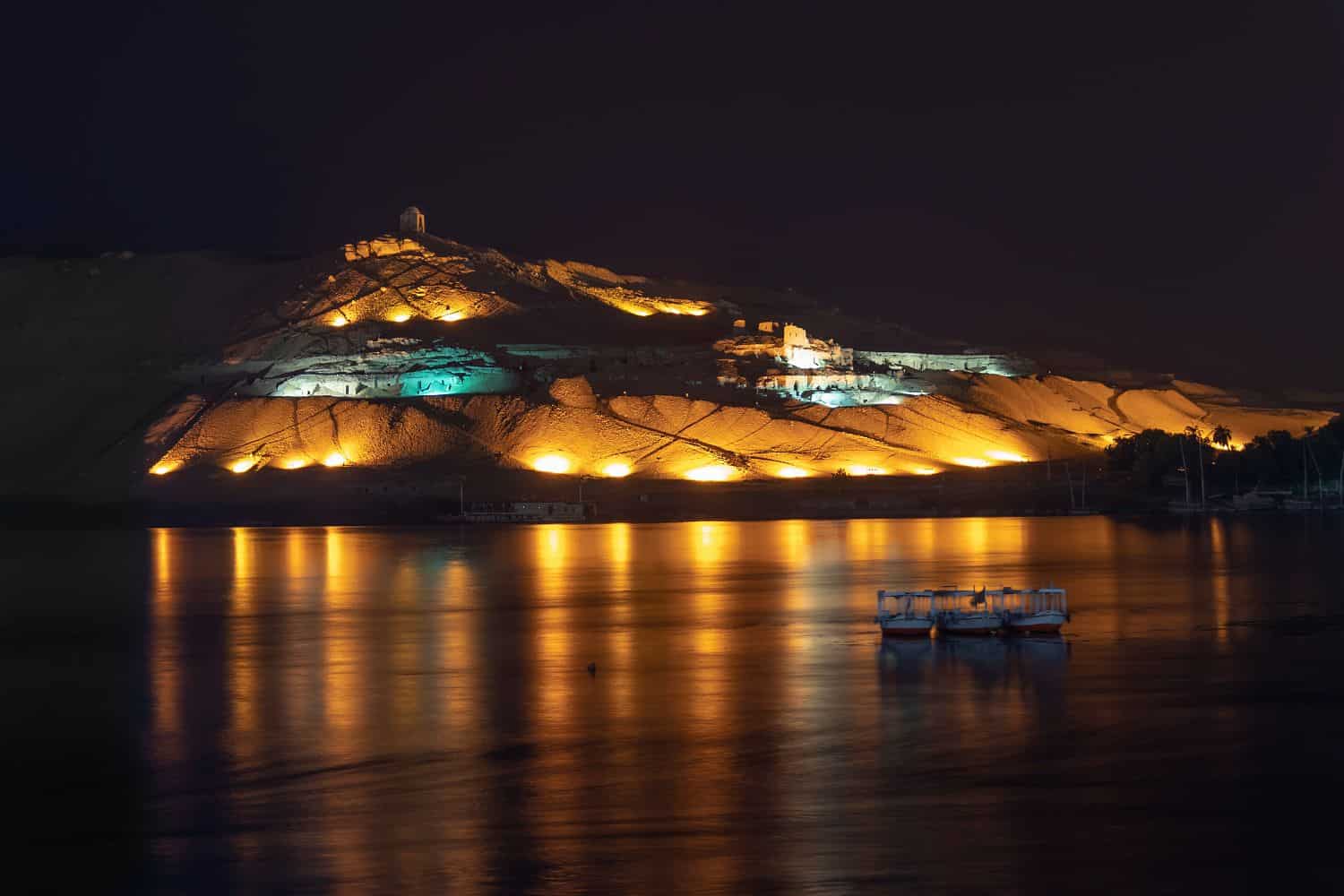
Updated On: February 19, 2024 by Eman Sameh
If Giza is the crown of Egypt, Saqqara is its heart, pulsing with a rich history that reveals itself in every intricate carving and grand mastaba. The mastabas, these time-encrusted tombs of the nobles, stand as silent custodians of the bygone era, with their secrets etched into walls and sealed within sarcophagi.
With their compelling blend of intricate architecture and profound symbolism, each tomb promises a unique story, a private glimpse into the lives and beliefs of the souls they shelter. The mastabas, enigmatic tombs of nobility, stand as silent custodians of history.
These architectural marvels, filled with intricate carvings and profound symbolism, hold secrets etched into walls and sealed within sarcophagi. From the ornate Tomb of Ti to the expansive Mastaba S3503, Saqqara invites exploration and reverence.
Join us as we unearth the timeless grandeur of Egypt’s first pyramid and navigate the labyrinthine network of tombs of the nobles. Saqqara isn’t just a journey to a place; it’s a voyage through time, a passage to the dawn of civilisation. So, ready your spirit for an adventure into the past. Saqqara awaits with its tales of eternity etched in stone, ready to be discovered.
Tombs of the Nobles Saqqara, A UNESCO Treasure Across Time
Step into the heart of Egypt at Saqqara, a UNESCO World Heritage Site recognised in 1979 for its unique cultural significance. This treasure trove of history, spanning from 2686 to 332 BCE, offers a rare glimpse into the evolution of an ancient civilisation.
As you wander through this vast necropolis, you’ll journey across the Old, New, and Late Periods of Egypt, witnessing firsthand the transformation of burial practices, tomb architecture, and artistic styles over millennia.
This remarkable timeline, etched in stone, makes Saqqara a living museum and a testament to Egypt’s enduring legacy. From the simplistic elegance of Old Kingdom tombs to the intricate artistry of the New Kingdom and the refined styles of the Late Period, every step is a leap through centuries.
The Mystery of Mastaba S3503
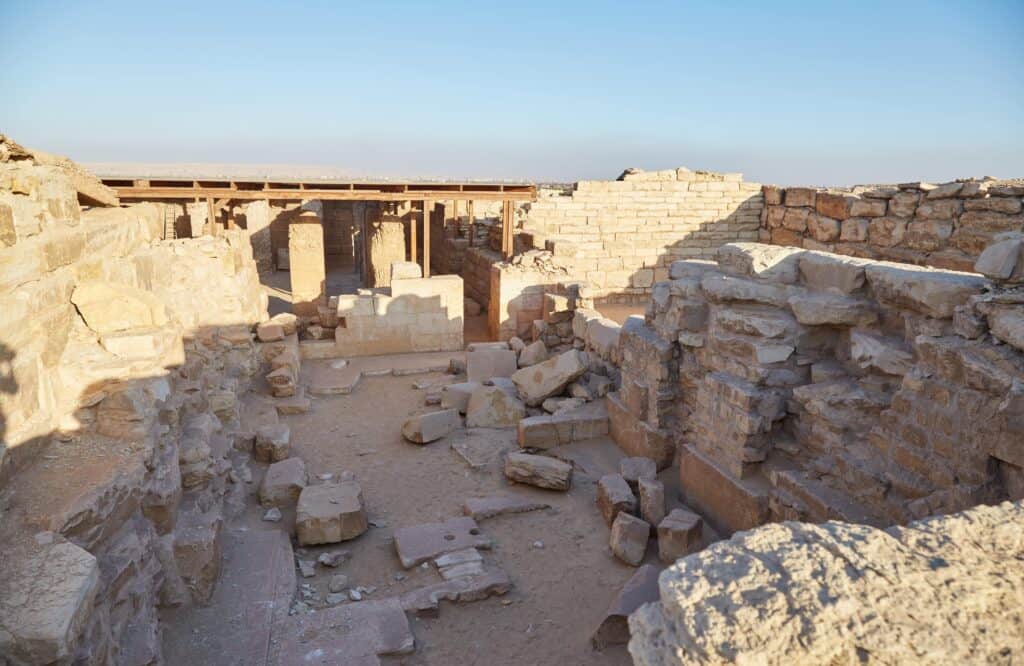
As you traverse the ancient sands of Saqqara, Egypt’s sacred burial ground, a thrilling enigma awaits you—the mysterious Mastaba S3503. This grand tomb, steeped in history and shrouded in mystery, hails from the epoch of the 1st Dynasty, around 3000 BC.
Mastaba S3503 is no ordinary structure. It’s a behemoth of sun-dried mud bricks, stretching 42 metres in length and 16 metres in width, proudly bearing the architectural elegance of a palace facade. Inside, a labyrinth of 23 chambers beckons the explorer in you, with an underground network featuring a large burial chamber adorned with four smaller chambers. Around the main structure, you’ll discover 20 additional tombs, each a story waiting to be unravelled.
Despite the wear of time and ancient looting, Mastaba S3503 continues to guard its legacy. Its central tomb chamber, home to a large sarcophagus, houses remnants of the past—a skeleton, bowls and vessels that once served as a meal for the departed, with stone and pottery vessels decorating the walls.
Even the remains of what might have been a canopy or a tent lie in wait, teasing the imagination with scenes of ancient rituals. But perhaps the most captivating allure of Mastaba S3503 is its occupant, a mystery that persists to this day. Though once believed to be the resting place of Queen Meritneith, discoveries at Abydos have since dismissed this theory. Now, some suggest the tomb could belong to an individual named Seshemka, but the truth remains as elusive as ever.
Discover Everyday Life Carved on Tomb of Ti
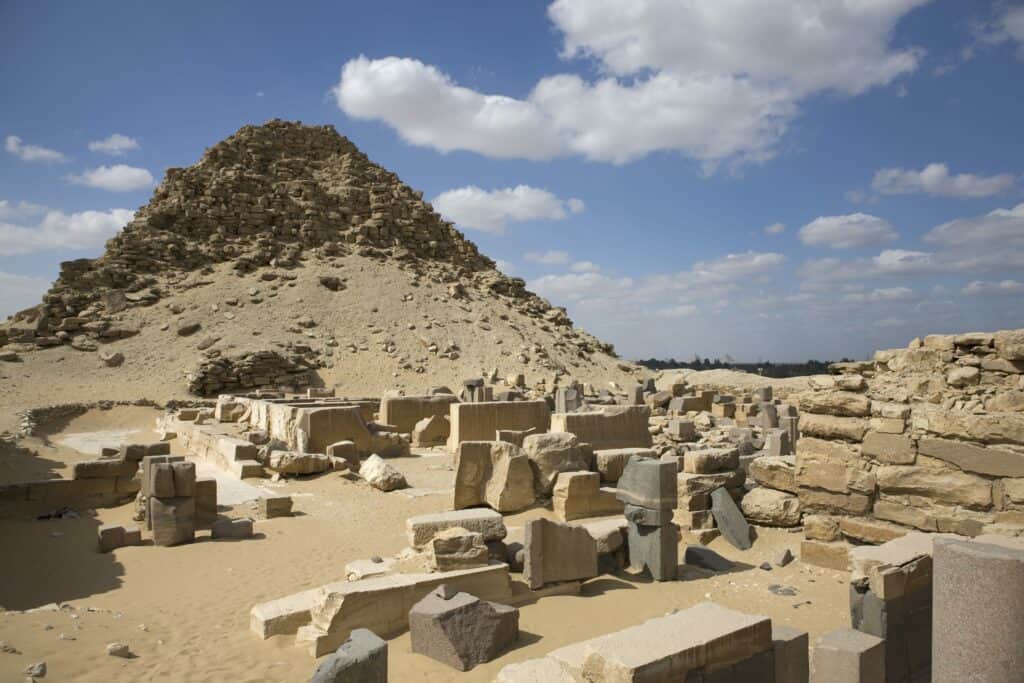
Step into the time capsule that is the Tomb of Ti in Saqqara, a testament to the magnificence of the Old Kingdom art. Unearthed in 1865 by Auguste Mariette, it is a vivid window into life in 5th Dynasty Egypt. Nicknamed “Ti the Rich,” the tomb’s owner served as overseer of the Abusir pyramids and sun temples, a high status that reflects his importance as an official during the 5th Dynasty.
This tomb isn’t just a monument; it’s a narrative. Life-size statues of Ti, his wife Neferhetpes, a priestess and ‘royal acquaintance’, and their two sons grace the offering hall. The walls, adorned with detailed reliefs, showcase everyday scenes, from farming and fishing to trading and dancing. The accompanying hieroglyphic dialogues, like ‘Hurry up, the herdsman is coming’ and ‘Pay up – it’s cheap!’, add an authentic flavour of Ti’s life as a royal overseer.
Embrace the opportunity to witness a day in the life of an Ancient Egyptian noble preserved for millennia in the Tomb of Ti.
The Extraordinary Mastaba of Mereruka
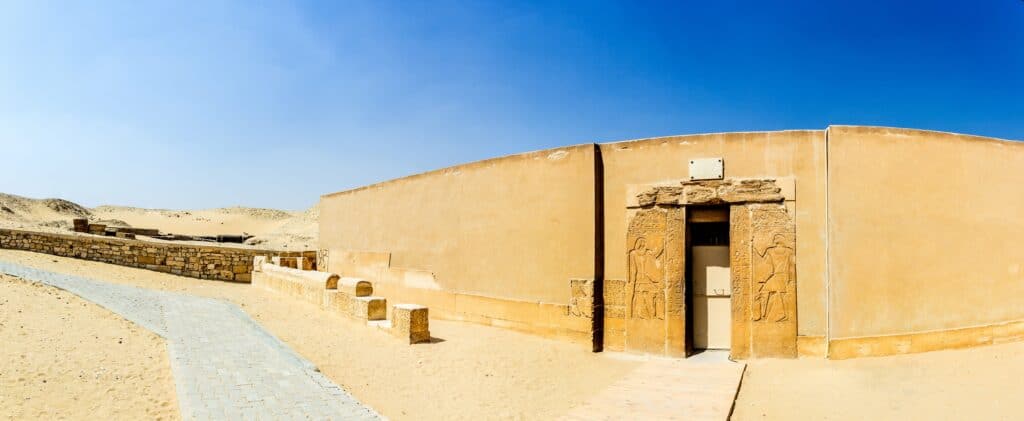
One of the highlights of this mastaba is the remarkable scenes that adorn its walls. These vivid illustrations provide an intimate look into life during the Old Kingdom.
Watch as scenes of cattle herding, hippopotamus harpooning, and fishing come to life before your eyes. Unique scenes of animals being force-fed, including the unusual presence of hyenas, add a touch of the extraordinary.
The mastaba also boasts a depiction of the three seasons of the ancient Egyptian calendar, personified in a way that leaves a lasting impression. The focal point of the tomb is the false door, a traditional element in ancient Egyptian tombs. Here, a life-size statue of Mereruka steps out, seemingly ready to receive the offerings set on the table before him. This tableau is a poignant reminder of the beliefs in the afterlife that permeated ancient Egyptian culture.
While the mastaba of Mereruka is a treasure trove of artistic and architectural wonders, its true value lies in its ability to transport you to another era. Each intricate carving in each grand room tells a tale of a time long past, offering a glimpse into the beliefs and life of Mereruka, a powerful man in the royal court of ancient Egypt.
Djoser Pyramid
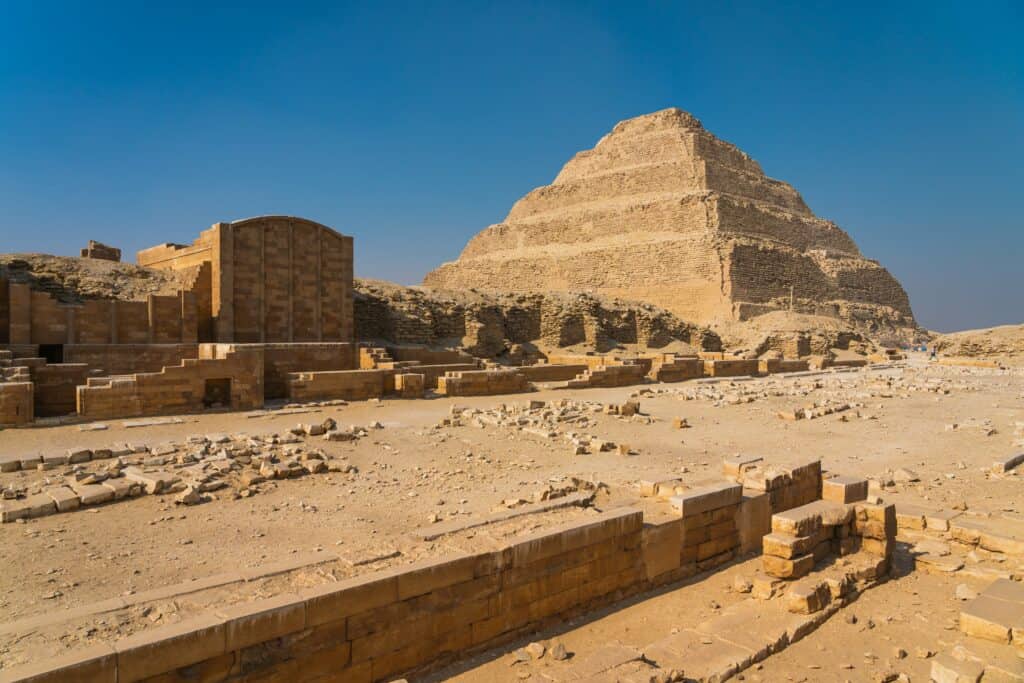
Rising from the sandy plateau of Saqqara, the magnificent Djoser Pyramid stands as a testament to ancient Egypt’s architectural prowess. This fascinating structure, built during the 27th century BCE, is not only Egypt’s first pyramid but also the earliest colossal stone building in the world.
Its groundbreaking design, consisting of six stacked mastabas, gave birth to the iconic pyramidal shape that would later define the royal tombs of pharaohs.
Standing tall for over 4,600 years, the Djoser Pyramid showcases the mastery of engineering and vision that propelled Egypt into a new era of monumental construction. Its enduring presence serves as a reminder of the timeless grandeur that still captivates visitors to this day.
After a 14-year restoration process, the pyramid, a symbol of Djoser’s grandiose vision, reopened for visitors in 2020. It continues to dominate the Saqqara landscape, and its influence can be traced to the architectural style of subsequent pyramids, including the iconic structures at Giza.
Even though the Dynastic Egyptians did not formally acknowledge him, most Egyptologists credit Imhotep with the design and construction of the complex. His work set the stage for the pyramids of the 4th, 5th, and 6th Dynasties and cemented the Step Pyramid of Djoser as a testament to architectural innovation.
Unusual Animal Burials
Venture beyond the human realm at Saqqara and find yourself amidst the ancient world’s most unique animal necropolises. Here, the lines between humanity, nature, and divinity converge, casting a light on the Egyptians’ profound respect for life in all its forms.
Explore the Serapeum, the final resting place for the revered Apis bulls, seen as earthly manifestations of the god Ptah. These bulls were revered in ancient Memphis and were allowed to live out their lives in luxury before being mummified and placed in a granite sarcophagus in the Serapeum.
But the homage doesn’t end there. Discover catacombs dedicated to birds, baboons, and more—each a sacred species in its own right, honoured in death as they were in life. Through these animal burials, Saqqara offers a lens into the ancient Egyptians‘ spiritual realm, where gods took many forms and animals held a place of reverence.
As for the discovery of the Serapeum, French archaeologist Auguste Mariette discovered the site in 1850. Mariette discovered the entrance to the Serapeum when his excavation team found the head of one of the statues that lined the path leading to the main burial area.
Pyramid of Unas
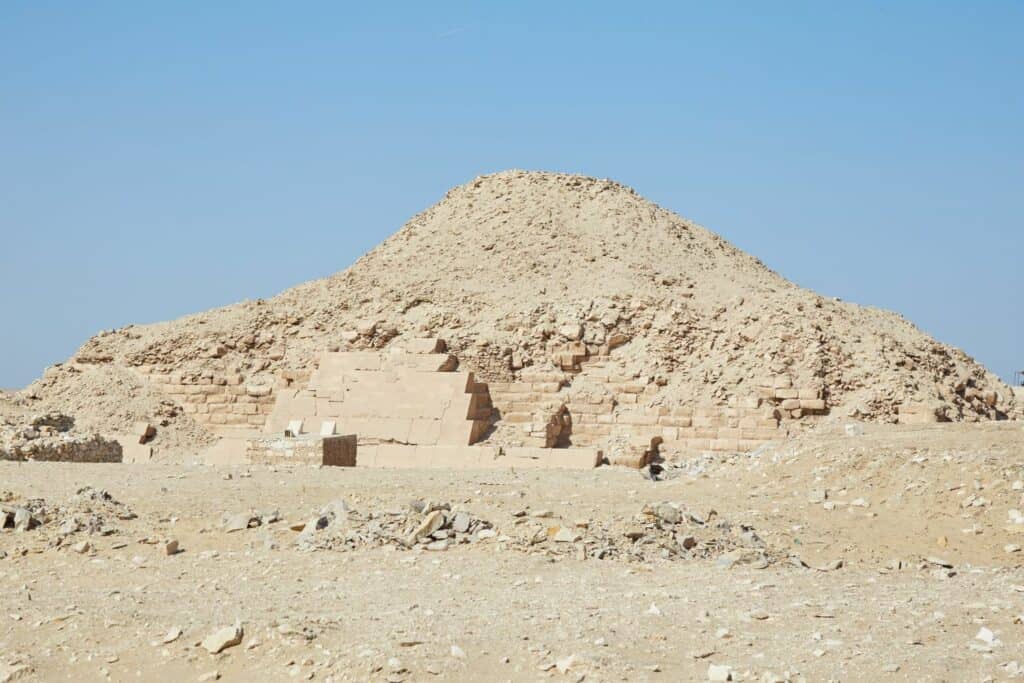
As the final resting place of Pharaoh Unas, this pyramid, built in the 24th century BC, is renowned for its beautifully preserved pyramid texts, a collection of sacred spells and incantations believed to guide the ruler’s journey into the afterlife.
Unas’s pyramid was unexplored until 1881 when French Egyptologist Gaston Maspero uncovered the Pyramid Texts, the oldest, smallest and best-preserved corpus of religious writing from the Old Kingdom. These ancient spells were intended to guide the ruler into eternal life, and their discovery in Unas’s pyramid marks their first known appearance. The texts ensured the ruler’s journey to eternal life, even if the funerary cult ceased to function.
Wondering if you can get a firsthand look at this fascinating structure? Good news! After over 20 years of closure, the Pyramid of Unas reopened to the public and now invites visitors to explore its historical depths. As we descend through the entrance chapel, we navigate a small corridor leading to an antechamber located directly under the pyramid’s centre axis. The thrill of anticipation builds as we venture deeper into the pyramid, stepping where only a select few have tread before.
The Mastaba Tomb of Mehu
The tomb of Mehu is a doorway to the past, offering us a glimpse into Mehu’s life and family. His two wives, Nebet and Neferkaus, are known, but the identities of his parents remain shrouded in mystery, sparking intrigue among those who delve into his story.
Several children of Mehu are mentioned in his tomb, including a son possibly named Mery and his grandson named Hetepka, whose name also appears in the mastaba as another Vizier, leading to speculation that he might have followed his grandfather’s footsteps and become a Vizier.
As we resurface from the pyramid, we can almost hear the echoes of the past, tales of pharaohs and the whispers of ancient spells. The Saqqara complex and the tomb of Mehu offer us an extraordinary journey into the past, a dive into history that leaves us with an enduring sense of awe and admiration for the ancient Egyptian civilisation.
Discoveries Are Still Being Made
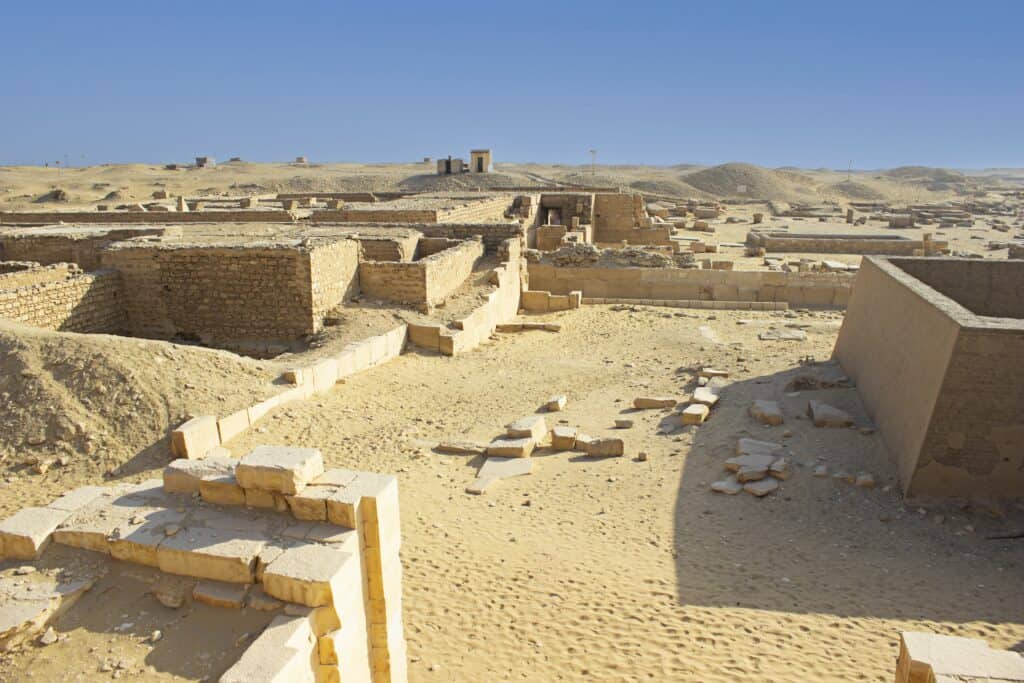
The sands of Saqqara, a silent sentinel to Egypt’s ancient past, are teeming with secrets yet to be unearthed. Even today, the site pulsates with the promise of discovery. In the span of a single year, archaeologists have revealed dozens of new findings, including two significant tombs dating back to the Old Kingdom, around 2500-2100 BC.
The tomb of a priest named Khnumdjedef and a palace official, Meri, nicknamed “the keeper of the secrets”, were discovered, accompanied by a trove of artefacts including statues, amulets, and a sarcophagus with a mummy cloaked in layers of gold. Adding to the air of mystery, a mummified teenage boy from around 300 BC was studied, revealing intricate amulets within his body, attesting to his high social status.
Saqqara continues to yield glimpses of a bygone era, with each new discovery painting a richer tapestry of ancient Egyptian life. Visitng Saqqara isn’t just a journey to a place; it’s a journey through time, a passage that transports you back to the dawn of civilisation and allows you to touch the threads that weave Egypt’s history together. The journey is just beginning, so pack your bags and prepare for an unforgettable expedition into the heart of Egypt’s ancient past.
Interested in hearing more about Egypt’s ancient past? Check out the article on the Tomb of Queen Nefertari.






